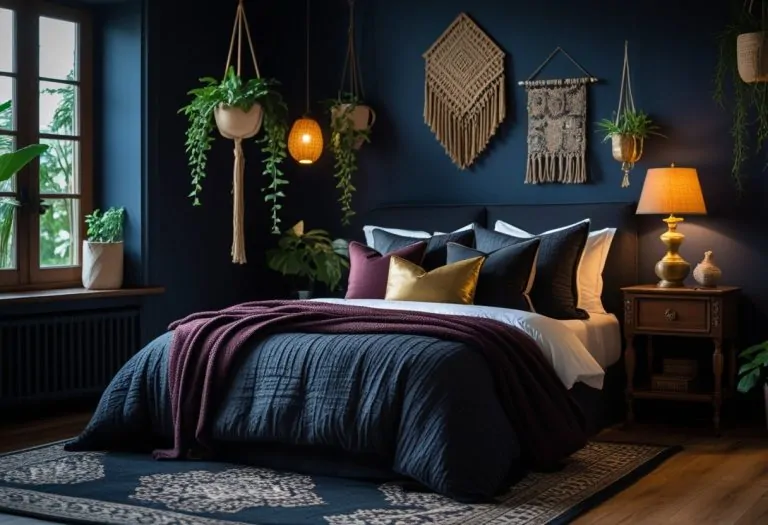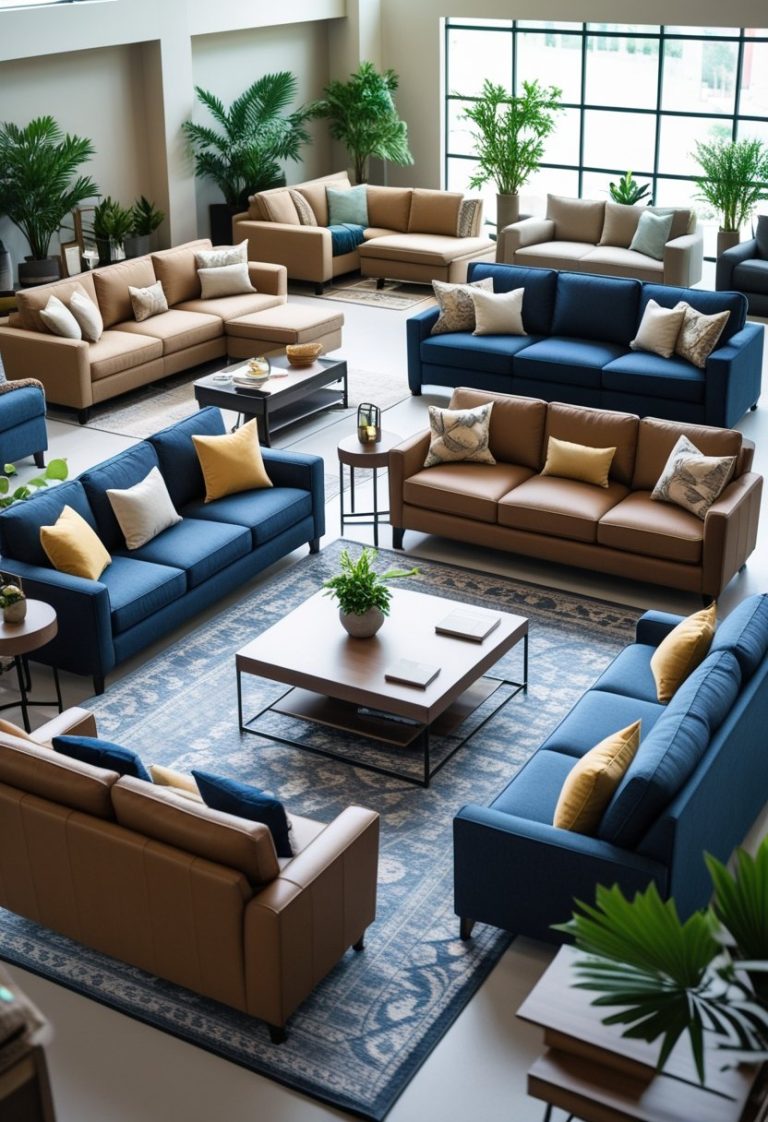Minimalist Living Room Tips for Clean, Functional Style
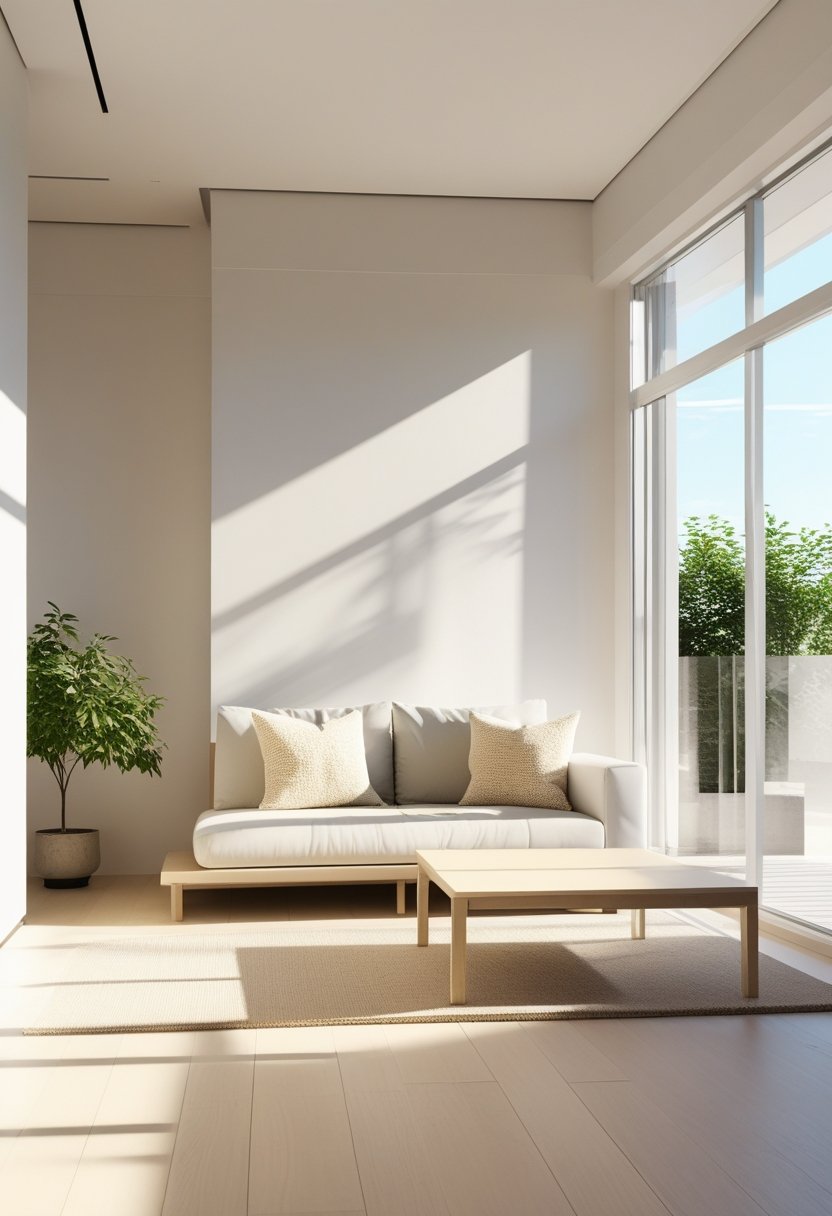
A minimalist living room focuses on simplicity by reducing clutter and emphasizing essential furniture and decor. It prioritizes functionality, clean lines, and a neutral color palette to create a calm and organized space. This design approach allows for a peaceful environment that feels both spacious and welcoming without unnecessary distractions.

Light and layout play key roles in a minimalist living room. Natural light, built-in storage, and thoughtful furniture placement enhance openness and flow while maintaining a stylish look. The goal is to blend comfort with order, making the room easy to use and visually appealing.
Minimalism does not mean stark or cold. It can incorporate warm textures, subtle colors, and personalized touches, balancing simplicity with character. This method transforms any living room into a serene retreat that supports relaxation and everyday function.
Principles of Minimalist Living Room Design

Minimalist living rooms focus on simplicity, functionality, and intentional choices. They create calming spaces by removing excess, emphasizing open areas, and selecting elements that contribute purposefully to the room’s atmosphere.
Defining Minimalism
Minimalism is a design philosophy centered on reducing clutter and emphasizing essential features. It values clean lines and open spaces to create an environment that feels spacious and peaceful.
In a minimalist living room, every item has a role, whether it supports comfort, function, or visual balance. The absence of unnecessary objects allows the room’s structure and design to stand out without distraction. Neutral or muted color palettes often accompany this style to enhance the serene feeling.
Core Elements of Minimalist Living Rooms
Key components define a minimalist living room: uncluttered layouts, simple furniture, and restrained decor. The space typically features:
- Functional furniture with clean lines and subtle design
- Open floor space to avoid overcrowding
- Neutral or soft color schemes such as whites, grays, or beiges
- Strategic lighting that highlights the room’s openness
Textural contrasts like natural wood or soft textiles add warmth without disrupting simplicity. The goal is to balance aesthetics and usability, ensuring that the room remains inviting but not overloaded.
Quality Over Quantity in Design
Minimalist design prioritizes quality over quantity. Fewer pieces are chosen, but they are often well-crafted and durable. Each element is selected based on its usefulness and contribution to the overall harmony of the space.
This approach encourages investment in furniture and decor that last and complement the minimalist aesthetic. Selecting versatile, timeless items also supports sustainability and reduces the need for frequent replacement, aligning with minimalist values beyond simple appearance.
Color and Light in Minimalist Living Rooms
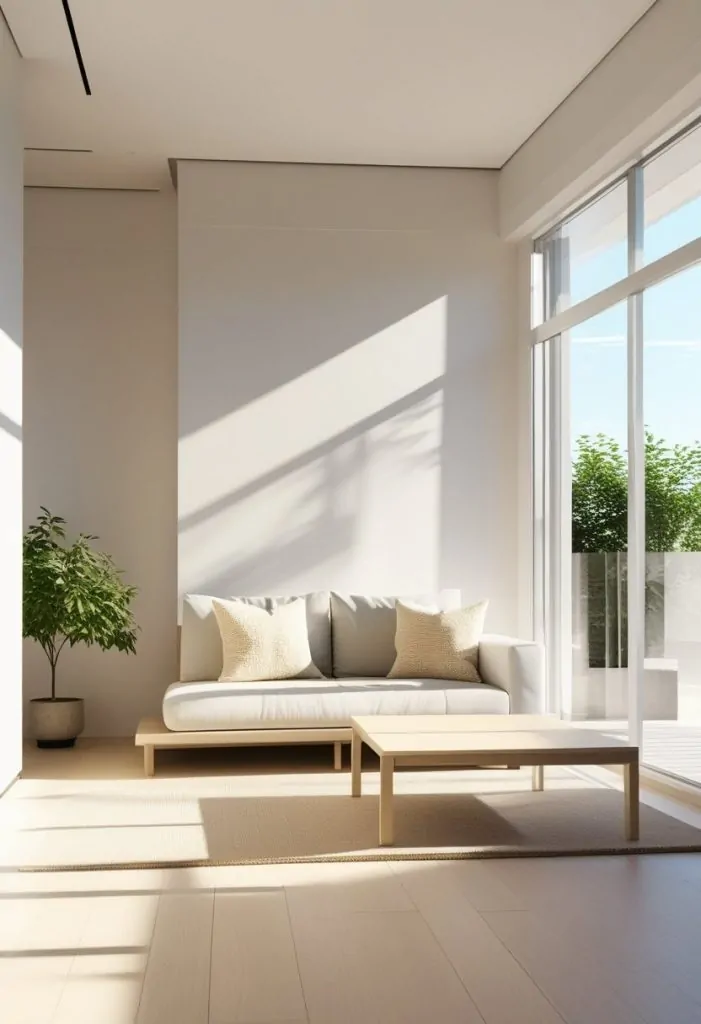
Minimalist living rooms rely on precise choices in color and light to maintain a calm, open atmosphere. The right selection of neutral tones, strategic use of accent colors, and careful attention to natural lighting influence both how spacious and inviting the room feels.
Neutral Color Palette Selection
A neutral color palette forms the foundation of most minimalist living rooms. Whites, soft grays, beiges, and earth tones create a clean, unobtrusive background that supports simplicity and openness. These hues work well on walls, furniture, and large surfaces to visually expand the space.
Using white walls is common because they reflect light efficiently, making rooms feel brighter and larger. Softer neutrals on textiles or wood elements add subtle warmth without disrupting the understated aesthetic. The goal is to avoid bold or saturated colors that dominate the space.
Adding Accent Color Thoughtfully
Accent colors in minimalist rooms should be used sparingly and purposefully. Small pops of muted tones—such as a single throw pillow or a framed piece of modern art—can provide visual interest without overwhelming the calm environment.
Preferred accent colors include muted blues, greens, or warm ochres because they complement neutral bases. The key is to keep these accents subtle and limited, maintaining balance and preventing clutter. Consistency in accents helps preserve cohesion across the space.
Maximizing Natural Light
Natural light is essential for minimalist living rooms to feel open and welcoming. Large windows or glass doors enhance this effect, allowing sunlight to highlight the clean lines and uncluttered layout.
Positioning furniture to avoid blocking windows helps maximize daylight penetration. Reflective surfaces like light wood tables or glossy finishes can further amplify natural light. Incorporating plants near windows adds softness without disrupting the minimalist ethos.
Using Window Treatments Strategically
Window treatments in minimalist spaces focus on function and simplicity. Sheer or light-filtering curtains in neutral shades maintain privacy while letting in natural light. Avoid heavy drapes or complex patterns that create visual noise.
Blinds with clean lines offer adjustable light control without detracting from the minimalist look. When choosing window treatments, it is important to match their color and texture with the room’s neutral palette to ensure seamless integration into the design.
Furniture Choices and Layout

A well-designed minimalist living room depends on careful furniture selection and thoughtful spatial arrangement. Choosing pieces that balance function with simplicity and arranging them to maximize openness are key steps to achieving a peaceful, uncluttered environment.
Selecting Essential Pieces
The focus is on choosing a limited number of furniture items that are both functional and visually simple. A slipcovered sofa, preferably in white or neutral tones, offers a clean, versatile look and easy maintenance. Wood furniture with sleek lines and minimal ornamentation supports the minimalist style by adding warmth without complexity.
Upholstery should be kept plain, avoiding heavy patterns or textures to maintain a calm atmosphere. Each piece must serve a purpose, whether for seating, storage, or surface space. For instance, a compact coffee table with clean lines or a bench that doubles as extra seating fits this principle.
Creating an Open Floor Plan
Maximizing open space is crucial in minimalist design style. Placing furniture to enhance movement without crowding the room creates a breathable, inviting atmosphere. Avoid overfilling the area; instead, leave clear pathways that visually expand the space.
An open floor plan benefits from aligning furniture with natural light sources, such as large windows, to create a bright, airy feeling. Arranging seating so it faces towards the room’s focal points or outdoor views promotes both comfort and flow.
Floating and Low-Profile Furniture
Floating furniture, like wall-mounted shelves or desks, helps maintain open floor space and reduces visual clutter. This technique complements minimalist design by emphasizing simplicity and functionality without overwhelming the room.
Low-profile furniture, such as sofas and chairs close to the ground, preserves an airy feel and keeps sightlines open. Such pieces often feature simple, rounded edges or organic shapes to soften the room’s geometric lines while staying true to minimalist principles.
Textures and Materials for Minimalist Appeal
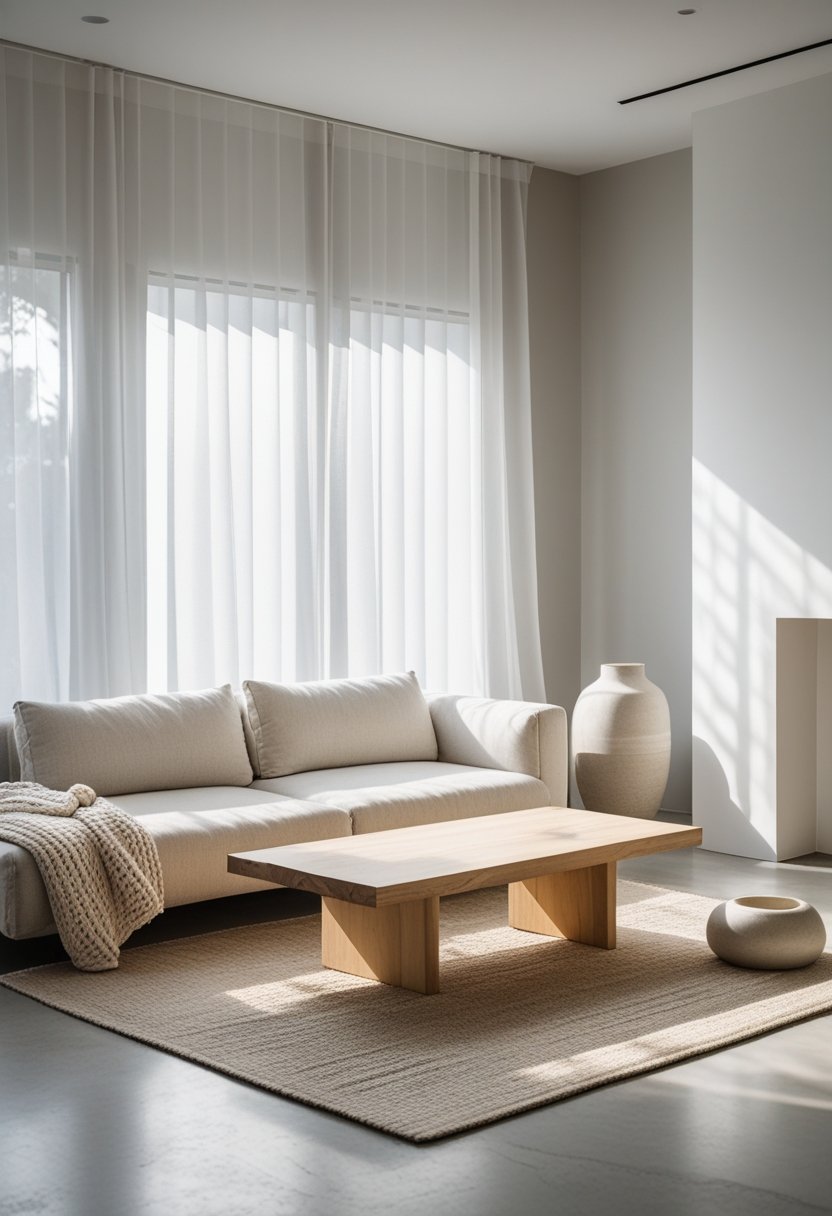
A minimalist living room benefits from thoughtful textures and materials that add depth without clutter. Using natural fabrics, layering soft textiles, and introducing tactile accents can create a balanced and inviting environment. These elements work together to maintain simplicity while enhancing warmth and visual interest.
Embracing Natural Materials
Natural materials play a central role in minimalist living rooms. Wood furniture, especially in light or neutral tones, provides both durability and organic warmth. It can be paired with stone or glass surfaces to maintain clean lines and understated elegance.
Textiles like linen and cotton are essential due to their breathable, soft qualities and understated texture. Woven baskets made from natural fibers serve as both functional storage and subtle decor, reinforcing an earthy, uncluttered aesthetic. Prioritizing materials with visible grain or texture helps convey simplicity with a tactile dimension.
Incorporating Area Rugs and Throws
Area rugs contribute significantly to the feel of a minimalist room. Wool rugs, with their natural fibers and gentle texture, add warmth and softness underfoot. Neutral colors and simple patterns are preferable to avoid visual distraction.
Throws and throw pillows made from linen or cotton can be layered to introduce additional texture while maintaining a calm palette. These textiles balance comfort and style and can be swapped seasonally. The key is avoiding excess while using these items to bring a cozy, lived-in feel without overwhelming the space.
Using Textured Accents
Textured accents provide subtle complexity to an otherwise streamlined room. Contrasting materials—such as a smooth wooden coffee table alongside a woven rattan basket—can create visual balance.
Small touches like a wool throw, rattan placemats, or a linen lampshade introduce tactile variety without adding clutter. The focus is on layering different textures within a restrained color scheme to sustain minimalism while preventing the space from feeling flat or sterile.
Storage and Decluttering Solutions

Maintaining a minimalist living room depends on effective decluttering paired with smart storage choices. Every item should have a specific place, and furniture that combines form with function can reduce visible clutter while enhancing utility.
Decluttering for Simplicity
Decluttering begins with a clear plan, usually tackling one area at a time to avoid overwhelm. Removing non-essential items simplifies the space and minimizes visual distractions.
A practical approach includes sorting items into categories: keep, donate, or discard. Limiting décor and personal items to those with functional or aesthetic value supports the minimalist ethos.
Regular maintenance prevents clutter accumulation. Frequent reassessment of possessions helps sustain simplicity and order over time.
Integrating Hidden Storage Options
Hidden storage offers discrete places to store belongings, keeping surfaces clear and the living room visually calm. Examples include built-in cabinets, wall units with concealed compartments, and storage beneath seating.
Choosing pieces with ample hidden space reduces the need for additional containers that can disrupt the minimalist style. This approach also ensures frequently used items remain easily accessible but out of sight.
Designers recommend relying on a few targeted hidden storage solutions rather than multiple small containers, as this limits clutter points and upholds a sleek appearance.
Smart Storage Furniture
Furniture that serves dual purposes is key in a minimalist living room. Examples include storage ottomans, lift-top coffee tables, and nesting side tables, all maximizing utility while minimizing clutter.
These multi-functional pieces help store items like blankets, magazines, and remote controls without adding visual noise. The choice of furniture should balance storage capacity with style consistency.
Selecting versatile furniture reduces the overall number of items needed, thereby supporting clutter reduction. Incorporating these pieces encourages a more organized and spacious environment.
Styling and Personalizing a Minimalist Living Room

A minimalist living room thrives on carefully chosen elements that maintain simplicity while reflecting personal taste. This involves defining a clear focal point, selecting purposeful decor, integrating natural greenery, and drawing inspiration from styles like Scandinavian design to achieve a balanced and inviting space.
Establishing a Focal Point
A strong focal point anchors the minimalist living room and guides the visual flow. It could be a large piece of art, a statement sofa, or a distinctive fireplace. The key is to select one item that naturally draws attention without cluttering the room.
Keeping surrounding elements neutral and streamlined enhances the impact of the focal point. Balance is essential; avoid overcrowding the area with competing features. A well-chosen focal point creates cohesion, making the space feel intentional and calm.
Minimalist Decor Accessories
Minimalist decor focuses on quality over quantity. Accessories should be functional or carefully curated to add subtle interest without overwhelming the room. Examples include a single sculptural vase, a sleek tray, or textured cushions in neutral tones.
Materials like natural wood, metal, and glass fit well in minimalist spaces due to their clean lines and understated elegance. It is important to keep surfaces mostly clear to emphasize openness while allowing accessories to add personality.
Incorporating Plants and Greenery
Plants introduce life and softness to a minimalist living room without compromising simplicity. Opt for greenery with streamlined shapes, such as snake plants, succulents, or fiddle leaf figs. These plants complement clean designs and require minimal care.
Plants should be displayed in simple pots, preferably in muted colors or natural materials, to maintain the uncluttered look. Strategically placed greenery can break monotony and improve air quality, supporting a calm and healthy environment.
Scandinavian Style Influences
Scandinavian design provides a strong foundation for minimalist living rooms. It emphasizes natural light, neutral color palettes, and functional furniture. Light woods, cozy textiles, and minimal ornamentation create warmth without excess.
This style values balance between simplicity and comfort. Incorporating elements like pale gray or white walls, streamlined sofas, and soft throws can make a minimalist room feel inviting. Scandinavian design encourages intentional use of space, blending style with practicality.


